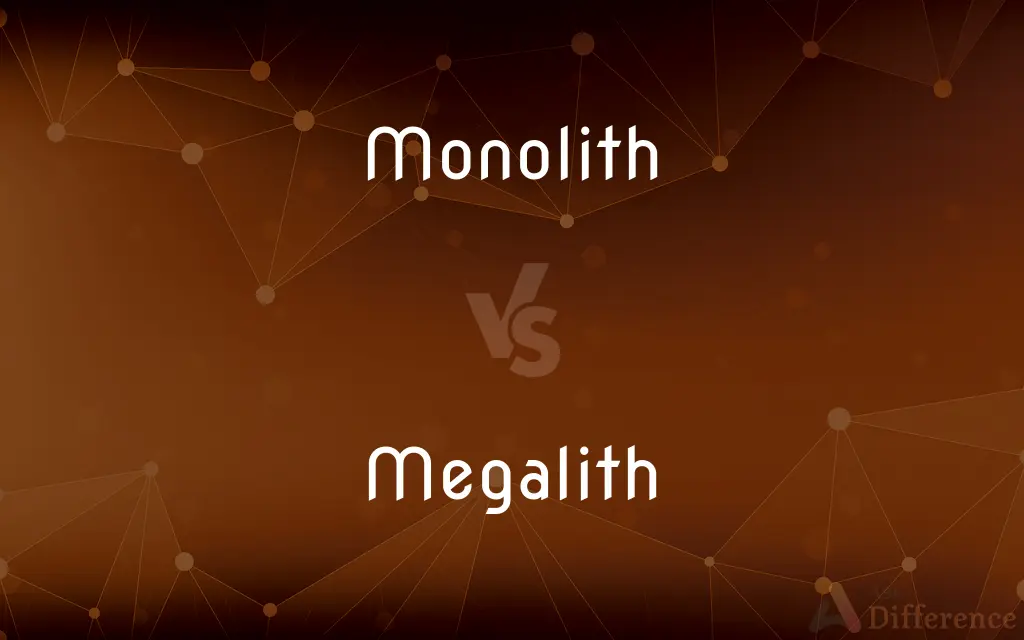Monolith vs. Megalith — What's the Difference?
Edited by Tayyaba Rehman — By Fiza Rafique — Updated on November 2, 2023
A monolith is a large single block of stone, while a megalith is a structure made of such large stones.

Difference Between Monolith and Megalith
Table of Contents
ADVERTISEMENT
Key Differences
A monolith is a geological feature or a structure consisting of a single massive stone or rock, such as a mountain or a large statue carved from one piece of stone. The term monolith comes from the Greek words 'monos', meaning single, and 'lithos', meaning stone. In comparison, a megalith is a construction involving multiple large stones, often arranged in a significant, mysterious, or monumental manner. Megaliths are typically associated with prehistoric structures like Stonehenge.
Monoliths stand alone and may be natural formations or engineered constructs. They can be found as natural geographic features, and they may also be erected as monuments or memorials. Conversely, megaliths refer specifically to the large stones used in the construction of complex structures or as single large stones that are part of a larger group, often with a cultural or ritualistic significance tied to ancient practices.
The concept of a monolith carries a metaphorical meaning as well, often used to describe an organization or system that is large, powerful, and intractably indivisible. Megaliths do not commonly share this metaphorical usage; their definition remains more literal, referring to the large stones of historical constructions that often puzzle archaeologists and historians regarding their true purpose and means of construction.
Monoliths are singular in their composition, even when used as building materials, such as obelisks or monolithic churches, which are hewn from one piece of rock. Megaliths can be arranged to form complexes, like stone circles or cairns, with each megalithic stone contributing to the larger structure, and they are not required to be fashioned from a single piece of stone.
While both monoliths and megaliths are usually ancient, monoliths can be part of modern construction, such as large, single-piece statues or monuments. Megaliths are primarily associated with prehistoric structures, and while new megalithic-style structures can be built, the term is most commonly used to refer to ancient works.
ADVERTISEMENT
Comparison Chart
Number of Stones
Single stone.
Multiple stones.
Formation
Can be natural or man-made.
Typically man-made.
Size
Usually large, but size can vary.
Consists of large stones.
Purpose
Can be natural, decorative, or commemorative.
Generally historical or ritualistic.
Construction
Carved or erected from one stone.
Built from several stones.
Compare with Definitions
Monolith
A monument or natural feature consisting of a single, massive stone.
The monolith was a sacred site for the indigenous people.
Megalith
A large stone used in various prehistoric architectures.
The megaliths at the site were aligned with the stars.
Monolith
An organization that is large, powerful, and intractably indivisible.
The government agency was an inefficient monolith.
Megalith
A massive stone erected by prehistoric peoples.
A single megalith marked the burial ground on the windswept moor.
Monolith
A large and impersonal political, corporate, or social structure.
The company was a monolith in the industry, dominating its competitors.
Megalith
A structure built from large stones, typically in the Neolithic period.
They wandered among the megaliths of the ancient stone circle.
Monolith
A monolith is a geological feature consisting of a single massive stone or rock, such as some mountains. Erosion usually exposes the geological formations, which are often made of very hard and solid igneous or metamorphic rock.
Megalith
A megalith is a large prehistoric stone that has been used to construct a structure or monument, either alone or together with other stones. There are over 35,000 in Europe alone, located widely from Sweden to the Mediterranean sea.The word was first used in 1849 by the British antiquarian Algernon Herbert in reference to Stonehenge and derives from the Ancient Greek.
Monolith
A large single upright block of stone, especially one shaped into or serving as a pillar or monument
We passed Stonehenge, the strange stone monoliths silhouetted against the horizon
Megalith
A large stone that forms a prehistoric monument (e.g. a standing stone) or part of one (e.g. a stone circle)
A smaller circle of some forty ancient megaliths
Monolith
A large, impersonal political, corporate, or social structure regarded as indivisible and slow to change
Independent voices have been crowded out by the media monoliths
Megalith
A very large stone used in various prehistoric architectures or monumental styles, notably in western Europe between 5000 and 2000 BC.
Monolith
A large block of stone, especially one used in architecture or sculpture.
Megalith
(archaeology)
Monolith
Something, such as a column or monument, made from one large block of stone.
Megalith
A large stone slab making up a prehistoric monument, or part of such a monument.
Monolith
An outcropping, cliff, or mountain having the appearance of a single block of stone
"On a waterway of grand pilot marks, the finest lay just ahead, Beacon Rock, a distinctive black monolith some eight hundred feet high" (William Least Heat-Moon).
Megalith
A prehistoric monument made up of one or more large stones.
Monolith
Something suggestive of a large block of stone, as in immovability, massiveness, or uniformity
"Standing against a global Communism it took to be monolithic, the Pentagon wanted to be taken as a monolith" (William Carroll).
Megalith
(by extension) A large stone or block of stone used in the construction of a modern structure.
Monolith
A large, single block of stone which is a natural feature; or a block of stone or other similar material used in architecture and sculpture, especially one carved into a monument in ancient times.
Megalith
A large stone; especially, a large stone used in constructing ancient monuments.
Monolith
Anything massive, uniform, and unmovable, especially a towering and impersonal cultural, political, or social organization or structure.
Megalith
Memorial consisting of a very large stone forming part of a prehistoric structure (especially in western Europe)
Monolith
(chemistry) A substrate having many tiny channels that is cast as a single piece, which is used as a stationary phase for chromatography, as a catalytic surface, etc.
Megalith
A monument consisting of huge stones.
The megalith stood as a testament to the engineering skills of ancient cultures.
Monolith
A dead tree whose height and size have been reduced by breaking off or cutting its branches.
Megalith
Any large stone used in prehistoric structures.
The archaeologist studied the megalith, searching for clues about its origin.
Monolith
(transitive) To create (something) as, or convert (one or more things) into, a monolith.
Monolith
(construction) To cast (one or more concrete components) in a single piece with no joints.
Monolith
To reduce the height and size of (a dead tree) by breaking off or cutting its branches.
Monolith
A single stone, especially one of large size, shaped into a pillar, statue, or monument.
Monolith
A single great stone (often in the form of a column or obelisk)
Monolith
A single large block of stone.
The ancient monolith towered over the surrounding landscape.
Monolith
A massive single rock or stone.
A solitary monolith stood at the center of the plateau.
Common Curiosities
Can monoliths serve a commemorative purpose?
Yes, monoliths can be erected as monuments or memorials.
What is a megalith?
A megalith is a large stone that forms part of a prehistoric structure or monument.
Are megaliths always part of a larger structure?
Typically, yes, megaliths are associated with complex structures or monuments.
What defines a monolith?
A monolith is a large, single block of stone, either natural or man-made.
Can monoliths be found naturally?
Yes, monoliths can be natural geological features.
Can a monolith be part of modern architecture?
Yes, the term can apply to modern constructions that use a single large stone.
How were megaliths constructed?
Megaliths were constructed using prehistoric techniques that often remain a subject of study.
Are megalithic structures found all over the world?
Yes, megalithic structures can be found globally, with various cultural significances.
Do monoliths have cultural significance?
Yes, many monoliths are of historical, cultural, or spiritual importance.
What is the difference between a monolith and a megalith?
A monolith is a single large stone, while a megalith refers to a large stone that is part of a bigger structure or group.
Are all megaliths ancient?
While most megaliths are ancient, the term can apply to any large stone used in construction.
What type of stone is used in monoliths and megaliths?
The type of stone can vary widely, often depending on the local geology.
Can monoliths be created artificially?
Yes, monoliths can be artificially created, such as large statues carved from a single stone block.
Is Stonehenge a monolith or a megalith?
Stonehenge is made up of megaliths.
Do megaliths have a religious background?
Many megaliths are thought to have had religious or ritualistic purposes.
Share Your Discovery

Previous Comparison
Worshiped vs. Worshipped
Next Comparison
Send vs. SentAuthor Spotlight
Written by
Fiza RafiqueFiza Rafique is a skilled content writer at AskDifference.com, where she meticulously refines and enhances written pieces. Drawing from her vast editorial expertise, Fiza ensures clarity, accuracy, and precision in every article. Passionate about language, she continually seeks to elevate the quality of content for readers worldwide.
Edited by
Tayyaba RehmanTayyaba Rehman is a distinguished writer, currently serving as a primary contributor to askdifference.com. As a researcher in semantics and etymology, Tayyaba's passion for the complexity of languages and their distinctions has found a perfect home on the platform. Tayyaba delves into the intricacies of language, distinguishing between commonly confused words and phrases, thereby providing clarity for readers worldwide.
















































